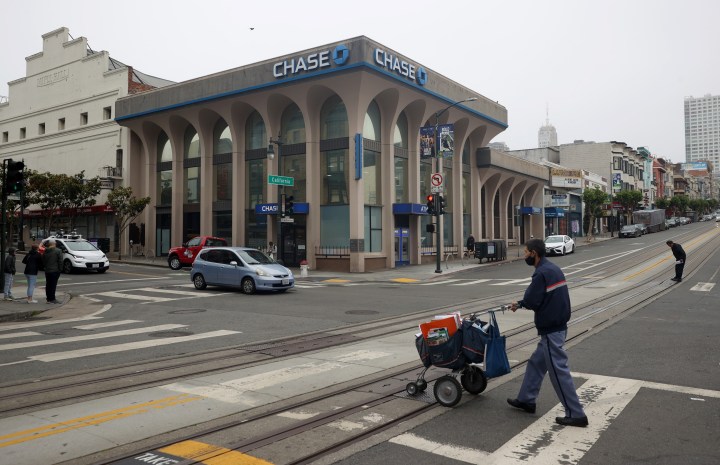
Why is there still a need for physical bank branches?

This is just one of the stories from our “I’ve Always Wondered” series, where we tackle all of your questions about the world of business, no matter how big or small. Ever wondered if recycling is worth it? Or how store brands stack up against name brands? Check out more from the series here.
Listener Paul Jones from South Portland, Maine, asked:
So much banking can be done online so why are there 40 credit unions and 30 banks in my area? Each year, large shiny brand new branches are opened.
You can now deposit a check, transfer cash and pay your bills with the convenience of a click.
Yet, despite the rise of online banking, physical banks still retain a presence in some communities. There are still many people (especially those who skew older) who aren’t used to managing their finances electronically, while some of the services that banks provide still require face-to-face interaction, according to Jaime Peters, assistant dean and assistant professor of finance at Maryville University of St. Louis.
“Additionally, we’re still a fairly large cash society, and you have to have a branch, especially if you’re a small business, and you’re dealing with cash in and cash out,” Peters said.
In 2020, there were almost 75,000 branches in the U.S., compared to about 85,600 in 2009, according to data from the Federal Deposit Insurance Corporation.
But like Jones from South Portland pointed out, some areas still have plenty of banks and credit unions, and some are even planning to expand.
American Banker, reporting on data from the National Credit Union Administration, said that at the end of September 2020, 745 credit unions had plans to add branches or expand facilities, and that there were a total of 21,000 credit union branches in the U.S.
Paul Legutko, senior principal at the financial-services advisory firm Aité-Novarica, said many financial institutions don’t want to close their branches because they think being embedded in the local community is “a selling point.”
Legutko said cases where banks have tried to enter a market exclusively digitally (i.e. increasing the amount they spend on digital marketing in a certain area) tend to have mixed results. He thinks this is because having a financial center, where you can go to resolve any issues, provides comfort to consumers.
“These are stressful times,” Legutko said. “If I’m applying for a mortgage, I don’t want to just leave that to an online application.”
Legutko said a study Aité-Novarica conducted last year found that 9 out of 10 consumers say having a branch nearby is important to them, even though only 3 out of 10 go to the branch.
Reynold Byers, a clinical professor of supply chain management at Arizona State University, said handling one’s finances can get confusing, which is why having a person step in to explain the process can be helpful.
“A lot of times if you try to find a way to get a good explanation of some detailed or complex loan or account, it’s hard to find that information on the website or the mobile app,” Byers said.
You’ll typically find physical bank branches near shopping areas or industrial areas, explained Peters. (Although Peters noted the ones in industrial areas are more on the decline.) And when it comes to credit unions, Peters said those are typically in places near the employers that are sponsoring them.
Some banks, like Capital One, have attempted to reinvent the concept of the bank to lure customers. Starting in 2015, the bank mixed credit cards with coffee by launching a series of cafés, some of which are still open.
And earlier this year, Citigroup Inc. Chief Executive Jane Fraser said the company was planning to add more branches in the U.S., while Chase announced in October that it’s already opened more than 220 branches since it announced an expansion plan back in 2018. By the end of 2022, Chase is aiming to open 400 new branches.
Byers said banks like Chase are opening up in places where they don’t have an established presence.
While banks may be ubiquitous in some areas, not everyone has access to one.
“You’ve got certain communities where you’ve got lots and lots of banks, and then you have other communities where there are no banks,” Legutko said, noting that these tend to be rural, lower-socioeconomic or underrepresented areas.
The unbanked rate for Black households in 2019 was 13.8% and 12.2% for Latinx households vs. 2.5% for white households, Marketplace reported last year.
Byers said that in banking deserts, consumers are often left to using less certain and more expensive financial services, like payday loans.
Experts agree that going forward, having physical banking in some form is necessary.
Elisabeth Honka, an associate professor of marketing at the University of California, Los Angeles, said that not only do some financial services need to be handled in-person, but there are areas where the internet infrastructure they have is not particularly robust.
“So online banking is not quite working out for consumers,” she said.
And Peters said she thinks physical banking will continue to have a role in the banking system for many years to come.
“There’s still some comfort when you’re talking about something so sensitive as your own money, that you are seeing the person face-to-face, that you feel like you know your banker,” Peters said.
There’s a lot happening in the world. Through it all, Marketplace is here for you.
You rely on Marketplace to break down the world’s events and tell you how it affects you in a fact-based, approachable way. We rely on your financial support to keep making that possible.
Your donation today powers the independent journalism that you rely on. For just $5/month, you can help sustain Marketplace so we can keep reporting on the things that matter to you.












